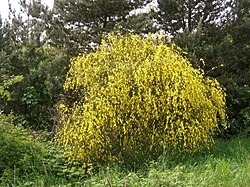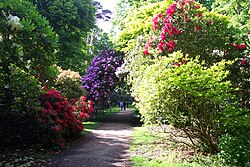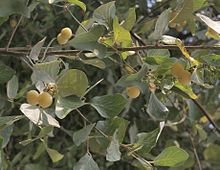Styrax is a genus of about 130 species of large shrubs or small trees in the family Styracaceae, mostly native to warm temperate to tropical regions of the Northern Hemisphere, with the majority in eastern and southeastern Asia, but also crossing the equator in South America. Common names include snowbell, styrax, and the more ambiguous storax and benzoin.
The genus Pamphilia, sometimes regarded as distinct, is now included within Styrax based on analysis of morphological and DNA sequence data. The spicebush (Lindera benzoin) is a different plant, in the family Lauraceae.
Styrax trees grow to 2–14 m tall, and have alternate, deciduous or evergreen simple ovate leaves 1–18 cm long and 2–10 cm broad. The flowers are pendulous, with a white 5–10-lobed corolla, produced 3–30 together on open or dense panicles 5–25 cm long. The fruit is an oblong dry drupe, smooth and lacking ribs or narrow wings, unlike the fruit of the related snowdrop trees (Halesia) and epaulette trees (Pterostyrax).
Uses
Uses of Resin
Benzoin resin, a dried exudation from pierced bark, is currently produced from various Styrax species native to Sumatra, Java and Thailand. Commonly traded are the resins of S. tonkinensis (Siam benzoin), S. benzoin (Sumatra benzoin) and S. benzoides. The name "benzoin" is probably derived from Arabic lubān jāwī (لبان جاوي, "Javan frankincense"); compare the obsolete terms "gum benjamin" and "benjoin". This incidentally shows that the Arabs were aware of the origin of these resins, and that by the late Middle Ages at latest international trade in them was probably of major importance.
The chemical benzoin (2-Hydroxy-2-phenylacetophenone), despite the apparent similarity of the name, is not contained in benzoin resin in measurable quantities. However, benzoin resin does contain small amounts of the hydrocarbon styrene, named however for Levant styrax (from Liquidambar orientalis), from which it was first isolated, and not for the genus Styraxitself; industrially produced styrene is now used to produce polystyrene plastics including StyrofoamTM.
History of sources
Since Antiquity, styrax resin has been used in perfumes, certain types of incense and medicines.
Styrax officinalis resin was mainly used in antiquity.
There is some degree of uncertainty as to exactly what resin old sources refer to. Turkish sweetgum (Liquidambar orientalis) is a quite unrelated tree in the family Altingiaceae that produces a similar resin traded in modern times as storax or as "Levant styrax," like the resins of other sweetgums, and a number of confusing variations thereupon. Turkish sweetgum is a relict species that occurs only in a small area in SW Turkey and not in the Levant at all); presumably, quite some of the "styrax resin" of the Ancient Greek and the Ancient Roman sources was from this sweetgum, rather than a Styrax, although at least during the former era genuine Styraxresin, probably from S. officinalis, was imported in quantity from the Near East by Phoenician merchants, and Herodotus of Halicarnassus in the 5th century BC indicates that different kinds of "storax" were traded.
The nataf (נטף) of the incense sacred to Yahweh, mentioned in the Book of Exodus, is loosely translated by the Greek term staktē!(στακτή, AMP: Exodus 30:34), or an unspecific "gum resin" or similar term (NIV: Exodus 30:34). Nataf may have meant the resin of Styrax officinalis or of some other plant, perhaps Turkish sweetgum, which is unlikely to have been imported in quantity into the Near East.
Since the Middle Ages, Southeast Asian benzoin resins became increasingly available; today there is little international trade in S. officinalis resin and little production of Turkish sweetgum resin due to that species' decline in numbers.
Use as incense
Styrax incense is used in the Middle East and adjacent regions as an air freshener. This was adopted in the European Papier d'Arménie. Though highly toxic benzene and formaldehyde are produced when burning Styrax incense (as with almost all organic substances), the amounts produced by burning a strip of Papier d'Arménie every 2–3 days are less than those achieved by many synthetic air fresheners. Styrax resin from southern Arabian species was burned during frankincense (Boswellia resin) harvesting; it was said to drive away snakes:
"[The Arabians] gather frankincense by burning that storax which Phoenicians carry to Hellas; they burn this and so get the frankincense; for the spice-bearing trees are guarded by small winged snakes of varied color, many around each tree; these are the snakes that attack Egypt. Nothing except the smoke of storax will drive them away from the trees."

Sumatra Benzoin (Styrax benzoin) parts drawing.
Franz Eugen Köhler. Köhler's Medizinal-Pflanzen in naturgetreuen Abbildungen, etc. 1887).
Medical user
There has been little dedicated research into the medical properties of styrax resin, but it has been used for long, and apparently with favorable results. It was important in Islamic medicine; Avicenna (Ibn Seena, ابن سینا) discusses S. officinalis it in his Al-Qanun fi al-Tibb (القانون في الطب, The Law of Medicine). He indicates that styrax resin mixed with other antibiotic substances and hardening material gives a good dental restorative material. Benzoin resin is a component of the "Theriaca Andromachi Senioris", a Venice treacle recipe in the 1686 d'Amsterdammer Apotheek.
Tincture of benzoin is benzoin resin dissolved in alcohol. This and its numerous derived versions like lait virginaland Friar's Balsam were highly esteemed in 19th-century European cosmetics and other household purposes; they apparently had antibacterial properties. Today tincture of benzoin is most often used in first aid for small injuries, as it acts as a disinfectant and local anesthetic and seems to promote healing. Benzoin resin and its derivatives are also used as additives in cigarettes.
The antibiotic activity of benzoin resin seems mostly due to its abundant benzoic acid and benzoic acid esters, which were named after the resin; other less well known secondary compounds such as lignans like pinoresinol, are likely significant too.
Horticultural uses
Several species of styrax are popular ornamental trees in parks and gardens, especially S. japonicus and its cultivars like 'Emerald Pagoda', and Styrax obassia.

Early summer blossoms of Styrax japonicus.
Uses of wood
The wood of larger species is suitable for fine handicrafts. That of egonoki (エゴノキ, S. japonicus) is used to build kokyū (胡弓), the Japanese bowed instrument.
Ecology and conservation
The resin of Styrax acts to kill wound pathogens and deter herbivores. Consequently, for example, few Lepidoptera caterpillars,eat styrax compared to other plants. Those of the Two-barred Flasher (Astraptes fulgerator) were recorded on S. argenteus, but they do not seem to use it on a regular basis.
Some styrax species have declined in numbers due to unsustainable logging and habitat degradation. While most of these are classified as Vulnerable by the IUCN, only four trees of the nearly extinct palo de jazmin (S. portoricensis) are known to survive at a single location. Although legally protected, this species could be wiped out by a single hurricane.
Selected species

Styrax obassia.

Styrax camporum parts drawing.
Johann Baptist Emanuel Pohl : Plantarum Brasiliae icones et descriptiones hactenus ineditae Vol. 1. (1827)
- Styrax agrestis China
- Styrax americanus – SE USA
- Styrax argenteus
- Styrax argentifolius - China
- Styrax bashanensis – China
- Styrax benzoides - Thailand, S China
- Styrax benzoin Dryand. – Sumatra Benzoin – Sumatra
- Styrax calvescens – China
- Styrax camporum Pohl
- Styrax chinensis – China
- Styrax chrysocarpus - China
- Styrax confusus – China
- Styrax cordatus – Peru and Ecuador
- Styrax crotonoides – Malaysia
- Styrax dasyanthus – central China
- Styrax faberi – China
- Styrax ferrugineus Ness et Mart.
- Styrax formosanus - China
- Styrax foveolaria - Peru
- Styrax fraserensis - Malaysia
- Styrax grandiflorus -– China
- Styrax grandifolius - SE USA
- Styrax hainanensis – S China
- Styrax hemsleyanus – China
- Styrax hookeri - Himalaya
- Styrax huanus - China
- Styrax jaliscana - Mexico
- Styrax japonicus - egonoki - Japan
- Styrax limpritchii - SW China (Yunnan)
- Styrax litseoides – Vietnam
- Styrax loxensis – Ecuador
- Styrax macranthus- China
- Styrax macrocarpus – China
- Styrax martii Seub.
- Styrax obassia – Japan, China
- Styrax odoratissimus – China
- Styrax officinalis L. – SE Europe, SW Asia
- Styrax pentlandianus – Bolivia, Colombia
- Styrax perkinsiae – China
- Styrax peruvianum – Peru
- Styrax philadelphoides - China
- Styrax platanifolius – Texas, NE Mexico
- Styrax pohlii A.DC.
- Styrax portoricensis – palo de jazmin - Puerto Rico
- Styrax redivivus – California
- Styrax roseus – China
- Styrax rugosus - China
- Styrax schweliense - W China
- Styrax serrulatus – Himalaya, SW China
- Styrax shiraianum – Japan
- Styrax socialis – Peru
- Styrax suberifolius - China
- Styrax supaii - China
- Styrax tafelbergensis – Suriname
- Styrax tonkinensis Craib – Siam Benzoin - SE Asia
- Styrax veitchiorum – China
- Styrax vilcabambae – Peru
- Styrax wilsonii - W China
- Styrax wuyuanensis – China
- Styrax zhejiangensis – China
Footnotes
- ^ Fritsch et al. (2001)
- ^ "Styrax". Natural Resources Conservation Service PLANTS Database. USDA. Retrieved 4 December 2015.
- ^ Wallnöfer (1997), Fritsch et al. (2001)
- ^ Herodotus of Halicarnassus (c.440 BC) III.107.2
- ^ Although Herodotus saw bones of many of "these [...] snakes", their having wings is hearsay information and either incorrect or refers to some kind of agama with neck or body ornaments. See Herodotus of Halicarnassus (c.440 BC) II.75.1-4.
- ^ Herodotus of Halicarnassus (c.440 BC) III.107.2:
ton men ge libanôton sullegousi tên sturaka thumiôntes, tên es Hellênas Phoinikes exagousi: tautên thumiôntes lambanousi: ta gar dendrea tauta ta libanôtophora ophies hupopteroi, mikroi ta megathea, poikiloi ta eidea, phulassousi plêtheï polloi peri dendron hekaston, houtoi hoi per ep' Aigupton epistrateuontai, oudeni de allôi apelaunontai apo tôn dendreôn ê tês sturakos tôi kapnôi.
- ^ Pastrorova et al. (1997)
- ^ Hébert et al. (2004), Brower et al. (2006)
References
- Brower, Andrew V.Z. (2006): Problems with DNA barcodes for species delimitation: 'ten species' of Astraptes fulgerator reassessed (Lepidoptera: Hesperiidae). Systematics and Biodiversity 4(2): 127–132. doi:10.1017/S147720000500191X PDF fulltext
- Fritsch, P.W.; Morton, C.M.; Chen, T. & Meldrum, C. (2001). Phylogeny and Biogeography of the Styracaceae. Int. J Plant Sci162(6, Supplement): S95–S116. doi:10.1086/32341 HTML abstract, first page image
- Herodotus of Halicarnassus (c.440 BC): The Histories. Annotated HTML fulltext of 1921 A. D. Godley translation.
- Pastrorova, I.; de Koster, C.G. & Boom, J.J. (1997): Analytical Study of Free and Ester Bound Benzoic and Cinnamic Acids of Gum Benzoin Resins by GC-MS and HPLC-frit FAB-MS. Phytochem. Analysis 8(2): 63-73. DOI:10.1002/(SICI)1099-1565(199703)8:2<63::AID-PCA337>3.0.CO;2-Y HTML abstract
- Hébert, Paul D.N.: Penton, Erin H.; Burns, John M.; Janzen, Daniel H. & Hallwachs, Winnie(2004): Ten species in one: DNA barcoding reveals cryptic species in the semitropical skipper butterfly Astraptes fulgerator. PNAS 101(41): 14812-14817. doi:10.1073/pnas.0406166101 PDF fulltext Supporting Appendices
- Wallnöfer, B. (1997). A revision of Styrax L. section Pamphilia (Mart. ex A. DC.) B. Walln. (Styracaceae). Annalen des Naturhistorischen Museums in Wien 99B: 681–720.
Wikipedia


























